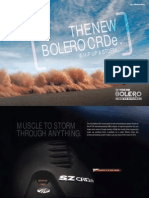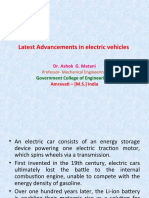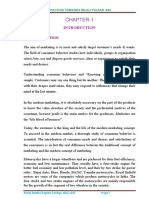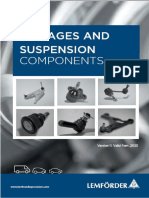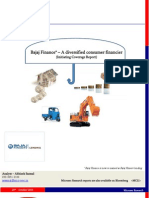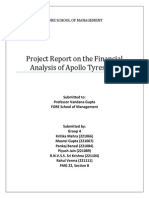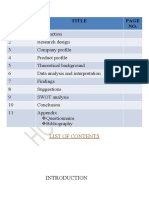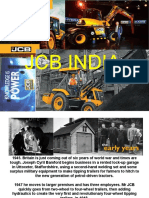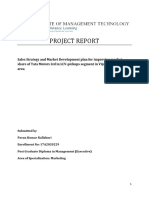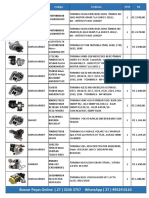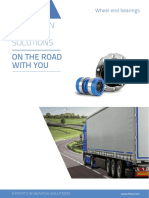Eicher Motors
Eicher Motors
Uploaded by
jehanbhadhaCopyright:
Available Formats
Eicher Motors
Eicher Motors
Uploaded by
jehanbhadhaCopyright
Available Formats
Share this document
Did you find this document useful?
Is this content inappropriate?
Copyright:
Available Formats
Eicher Motors
Eicher Motors
Uploaded by
jehanbhadhaCopyright:
Available Formats
Eicher Motors Ltd
Volvos play on India Story
Rating Date CMP T.P (Dec 2012) Upside BUY 23rd FEB 2012 INR 1716 INR 2118 23%
Eicher Motors (EM) is a play on Volvos India story. It is capturing MHCV market share through stronger growth despite unfavorable macro environment on the back of Volvos superior technology, enhanced fuel efficiency and lower maintenance requirement. We believe EM is the best long term play within the Indian CV industry.
COMPANY DATA Industry Equity (INR mn) Face Value Auto 269 10
VOLVO-EICHER COMMERCIAL VEHICLES ~ AT INFLECTION POINT Volvo-Eicher Commercial Vehicles (VECV) JV is the fastest growing CV company in India. VECV aims to capture 15% of the MHCV (>12T) market by 2015. Given VECVs current low market share of 3.6%, there exists significant headroom for growth. Given companys focus on strengthening aftermarket and improvement in product offering
KEY MARKET DATA BSE Code BSE Group NSE Code Bloomberg Code Mkt Cap. (INR Bn.) 52 Week high/low Monthly Turnover 505200 B EICHERMOT EIM IN 40.5 1762 / 975 11 mn
using Volvos proven technology, we believe EM is well poised to clock a 15% volume CAGR over CY11-15E. However given the near term concerns of a slowdown in industrial growth and high interest rates we have built in considerable moderation in CY12E volume growth at 13%. (Our CY12E growth for the CV industry stands at 7%).
ROYAL ENFIELD ~ RETURN OF THE JEDI Royal Enfield has completely switched over to an upgraded platform which has increased fuel efficiency from 30-35 km/l to 40-45 km/l. The gears and brakes have been shifted to the conventional left hand side of the bike. Production capacity will
SHARE HOLDING PATTERN (Dec 11)
increase from 84,000 units to 1,50,000 units. The above points combined will lead to sustained sales and provide for visibility in the coming years.
Promoters MFs, FIs, Banks FIIs Others
55% 18% 6% 21%
STRONG FINANCIAL POSITION EM has a consistent track record of generating positive free cash flow which is expected to continue going forward. EM has an upper hand over both the incumbents
PRICE PERFORMANCE Returns (%) 3 Month 6 Month 12 Month * Benchmark Abs 7 27 63 Rel.* -5 16 64 Sensex
in terms of its financial ratios ROCE, asset turnover and debt/equity.
STRONG REVENUE GROWTH OVER THE NEXT 5 YEARS EM is expected to witness robust growth rates over the next five years on the back of (a) Increase in VECVs market share in the MHCV industry (it was just 3.6% in CY11) (b) Doubling of capacity for Royal Enfield bikes to meet the ever growing demand
Analyst Contact No Email
Jehan Bhadha 022 43022128
(c) Engine project under VECV JV will give a further fillip to the JVs revenue growth and help it emerge as a potential candidate for future components outsourcing opportunities from Volvo.
jehan-bhadha@darashaw.com
Summary Financials INR Mn. CY10 CY11 CY12E CY13E CY14E Sales 43,971 56,775 66,595 84,892 106,536 YoY 71% 29% 17% 27% 25% EBIDTA 3811 5935 7040 8813 11596 Margin 8.7% 10.5% 10.6% 10.4% 10.9% PAT 1889 3103 3449 4196 5472 Margin 4.3% 5.5% 5.2% 4.9% 5.1% EPS 70 115 128 156 203 YoY 21% 64% 11% 22% 30% RoE 15% 18% 16% 15% 15% P/E 24.5 14.9 13.4 11.0 P/BV 3.8 2.8 2.1 1.7
Eicher Motors Ltd
Volvos play on India Story
COMPANY BACKGROUND Eicher Motors (EM) primarily manufactures commercial vehicles (CVs) and motorcycles. It operates out of its main manufacturing facility in Pithampur (central India). EM is the second largest domestic player in ICVs (7.6T-12.5T) and the third largest player in the overall CV industry. EM is promoted by Delhi-based Vikram Lal. Currently, it is managed by the second generation promoter - Siddhartha Lal, who took over charge as group CEO since January 2004. Mr Siddhartha has been associated with the company in different roles since 1999. Key Milestones 1948 1959 1984 1991 1993 2005 2008 Eicher begins to sell imported tractors Indias first tractor rolled out of Eichers factory JV with Mitsubishi motors to make trucks Acquired Royal Enfield motorcycles Ended JV with Mitsubishi and entered CVs Divested tractor business to focus on CVs & motorcycles Formed JV with Volvo of Sweden, transferred CV business to the JV Top Management Siddhartha Lal Vinod Aggarwal Venki Padmanabhan MD CEO VECV CEO Two Wheelers
EICHER MOTORS GROUP STRUCTURE
Eicher Motors
Royal Enfield
VECV (Volvo Eicher CV) 54.4%
VECV - Segments
Eicher Trucks & Buses
Eicher Engineering Solutions
Volvo-Eicher Powertrain
Volvo Trucks India (Sales & Aftermarket)
Eicher Engineering Components
Source: Darashaw
Eicher Motors Ltd
Volvos play on India Story
Revenue Mix CY10 Revenue: INR 44 bn Royal Enfield 10%
PAT Mix CY 10 Revenue: INR 1.9 bn
VECV 60% Royal Enfield 40%
VECV 90%
Source: Darashaw
Source: Darashaw
EM has a 54% stake in VECV JV and thus proportionate share of profits of the JV are transferred to the associate company (Volvo). Hence although VECV contributes 90% to the revenues of the consolidated entity, its contribution to PAT is lower at 60%. This is to highlight the significance of Royal Enfield and not get influenced by its lower share in revenues.
INVESTMENT RATIONALE
BUSINESS RESTRUCTURING EXERCISES (FY04-08) FY04 FY06 FY06 FY07 FY08 CY08 CY08 CY08 CY08 CY09 Tractor, two wheeler, gear businesses de-merged from Eicher Ltd and merged into EM Sold tractor business in June 2005 to TAFE Acquired DIE (Design Intent Engineering) USA for USD 2.5 mn Acquired Hoff & Associates USA for USD 3.5 mn Hoff merged with DIE and renamed as EES (Eicher Engineering Solutions) Formed JV company with Volvo for CV business having a stake of 54.4% EES transferred to VECV in July 2008 Standalone company has only two wheeler business and investment in VECV Volvo acquires 8.1% stake in EM from promoters Buyback from minority investors for 1.41 mn shares (5% of equity)
ADVENT OF VECV JV EM attempted to enter HCV goods segment over FY05-08, however it was unsuccessful. Truck operators are highly sensitive to break-downs and the sensitivity increases with increase in tonnage. Hence EM needed a strong technology partner to ensure quality and garner acceptance for their product. Volvo had occupied a niche in Indian CV market for 10 years and wanted to get into the mass market pie, but knew they needed a partner who understood the mass market. Volvo went with EM because of EMs established presence in the domestic CV industry. Over the past two years the JV has led to emergence of a stronger Eicher brand, with improved technology and quality and increased product acceptance significantly outperforming the industry over 2009-till date. Given high sensitivity of customer to breakdowns, EM is strongly focusing on strengthening aftermarket support. That is where Tata Motors derives its strength in the North and Ashok Leyland in the South. VECV Deal Structure Eichers CV and related components business was transferred to the JV company VECV Volvo acquired a 45.6% stake in VECV for USD 350 mn. USD 275 mn as cash and USD 75 mn for Volvo Trucks India (distribution & sales of Volvo trucks + distribution & sales and aftermarket of Volvo buses) Post this JV, Eicher has a non-compete clause with Volvo within commercial vehicles. All future projects of Volvo in India will be routed through the JV. VECV will be jointly managed by Volvo and EM with equal representation on the board. Volvo acquired 8.1% stake in EM at INR 691.7 per share. As a reslt, the direct and indirect holding of Volvo will be 50% in the JV.
Eicher Motors Ltd
Volvos play on India Story
VECV TARGETS 15% OF MHCV MARKET (>12T) BY CY15/FY16; INITIAL SUCCESS SIGNS VISIBLE We believe EMs JV (VECV) with Volvo, the worlds second largest truck company (after Diamler), is a defining moment as this association gives EM the technology and financial muscle required to grow its presence in the domestic MHCV industry. VECV aims to capture 15% of the MHCV market by 2015. Given VECVs current low market share of 3.6%, there exists significant headroom for growth.
6% MHCV M.S FY12E
3.6%
MHCV Market Share
15% 15%
23%
TAMO AL Eicher Others
12% 9% 6% 3% 3.6% 7.5%
67%
0%
C Y11 C Y15E (Target) C Y15E (Our Estimate)
Source: CMIE
Source: Company, Darashaw
EM - MHCV M.S - Initial success signs visible 4.0% 3.5% 3.0% 2.5% 2.0% 1.5% FY07 FY08 CY09 CY10 CY11
16% C Y10 71% 13%
Shift in Product Mix towards MHCV
15% 14%
64%
62%
Buses <12T MHC V (>12T)
21% C Y12E
24% C Y15E
Source: Darashaw
Source: Darashaw
Given companys focus on strengthening aftermarket and improvement in product offering using Volvos proven technology, we believe EM is well poised to clock a 15% volume CAGR over CY11-15E. However given the near term concerns of a slowdown in industrial growth and high interest rates, we have built in considerable moderation in CY12E volume growth at 7%. (Our CY12E growth for the CV industry stands at 2%)
VECV - CV Volume Growth Forecast Volumes 90000 80000 70000 60000 50000 40000 30000 CY11 CY12E CY13E CY14E CY15E
Source: Darashaw
Grow th 30% 25% 20% 15% 10% 5% 0%
Timeline By Jan 2012 By Jan 2013 By Jan 2014 By Jan 2015
Capacity Per Month 4,500 5,500 7,000 8,300 Per Annum 54,000 66,000 84,000 100,000
Source: Darashaw
Eicher Motors Ltd
Volvos play on India Story
VECV has following segments Eicher Trucks and Buses (ETB) The core activities of the JV come under this segment. The segment manufactures trucks and buses of capacities ranging from 5-40T. However, it has a strong presence in the Light/Medium Duty segment in 7T-12T category. The company is further strengthening its presence in 16T and higher segments. Eicher Engineering Components (EEC) Eicher Engineering Components is the outcome of strategic backward integration. The manufacturing facility not only meets the internal demand, but also has a large market share. EEC manufactures some components (In-house Products), assembles a part of the portfolio (Gearbox Assemblies), and outsources some components (Outsourced Products), to provide end-to-end solution to its customer base. Eicher Engineering Solutions (EES) The company is into design and CAE (computer aided engineering) services. It has two main business areas EES Inc. (US) and EES Gurgaon (Delhi). Its customers include Toyota, Nissan, Harley Davidson, Navistar, Siemens etc. Volvo Trucks India Engages in sales and distribution of Volvo trucks in India. VECV is also engaged into sales & distribution and aftermarket (servicing) of Volvo buses. This being a trading business, margins here are substantially lower. Volvo Eicher Powertrain (VEPT) Engine Project As a strategic measure, the project Volvo Eicher Powertrain (VEPT) is based on Volvo Groups decision to make VECV the base for its futuristic Medium Duty Engine global platform.
VOLVO-EICHER POWERTRAIN VEPT (ENGINE PROJECT) ~ MAJOR LONG TERM GROWTH DRIVER Volvo Groups decision to make VECV its base for its future Medium Duty Engine global platform demonstrates Volvos trust in VECVs manufacturing capabilities. The project will be a major long term growth driver for the JV. VECV will invest INR 4.8 bn into a new plant to manufacture Medium Duty Engines (5-8 liter engines) for Volvos global requirements. Most countries in Europe will witness a change in emission norms which will upgrade from Euro 3/4 to Euro 5/6. Given the low cost base in VECV, Volvo will source its Medium Duty engine requirement from this JV. Deutz currently supplies 48 litre engines to Volvo for CV and Construction Equipment. Apart from Volvo it supplies engines to Renault Trucks and Buses. Volvo accounts for 30% of Deutz total revenues. Volvo sources its Heavy Duty engines from Cummins, US. Volvo holds 6.7% in Deutz, Germany (INR 2 bn) in comparison to 46% economic stake in VECV (INR 11 bn), which we believe could be one more reason for Volvo selecting VECV for its Medium Duty Engine Project. This will also bring in a huge advantage to Eicher trucks when India advances to Euro 5 and Euro 6 emission standards. Currently India is in the Euro 3 stage. VECVs Medium Duty Engine Project for Volvos global requirements brings potential for similar large component sourcing projects for Volvos global requirements within the CV space. VECV is already producing about 50,000 engines per year in its existing Pithampur plant. The new investment in Pithampur will result in an annual production capacity of an additional 85,000 engines; starting 2013. Of these 85,000 engines, a significant number (30,000-40,000 base engines) could be sent to Volvos plant in Venissieux, France where these base engines will be assembled for its Euro 5 and Euro 6 requirements, starting 2013.
Eicher Motors Ltd
Volvos play on India Story
ROYAL ENFIELD RETURN OF THE JEDI The brand Royal Enfield is associated with adjectives such as rough & tough, cult and distinctive. This brand is targeted towards well built class of people. Rising income coupled with favorable demographics, entry of global players like Harley Davidson has further promoted this culture. The bikes of global players are too expensive and EM faces minimal competition in its 350+ cc bikes. Thus Royal Enfield is well positioned to capitalize on the strong and growing demand for its products (6-8 months waiting period). From October 2010, Royal Enfield has completely switched over from the old cast iron to the new all aluminum unit construction engine (UCE) platform. The UCE platform has an integrated assembly for the engine, gear box and clutch and this reduces the friction between the movable parts, resulting in lower transmission losses and higher fuel efficiency (from 30-35 km/l to 40-45 km/l). The company also moved gears and brake to conventional left hand side of the bike. Going forward, the company will use this platform to introduce an entire new range of high end bikes. EM has completed planning of its new plant of Royal Enfield and expects it be up and running from Q1CY13E. Production capacity will increase from the current 84,000 units to 1,50,000 units. The run rate for Royal Enfield has increased to ~7,000 units per month from ~4500 units per month in 2010. We believe that new model introduction, restyling of products and addressing capacity concerns are likely to result in strong volumes for the company going forward.
Royal Enfield - Volumes & Sales Growth Volumes 120000 90000 60000 30000 0
FY05 FY06 FY07 FY08 C Y09 C Y10 C Y11 C Y12E C Y13E
Grow th 50% 40% 30% 20% 10% 0%
We expect a 23% CAGR for Royal Enfield volumes between CY11-13E driven by strong demand and expanded capacity.
Source: Darashaw
CAPEX PLANS EMs capital expenditure for the next three years amounts to INR 11.3 bn. It plans to expand its Royal Enfield capacity to 150k units by 2012-end with capex of INR 1.5 bn. CV capacity is also being expanded from annual 50k units to 100k units by 2015 end with capex of INR 5 bn. For the medium duty engine project VECV plans to invest INR 4.8 bn for additional capacity of 85k units. Current Capacity CV Engine Project 2 Wheeler 50,000 50,000 84,000 Expanded Capacity 100,000 135,000 150,000 Completion Date Dec15 Dec12 Dec12 CY12 1.6 3.8 1.2 6.6 Amount in INR bn CY13 1.7 1.0 0.3 3.0 CY14 1.7 0.0 0.0 1.7 Cumulative 5.0 4.8 1.5 11.3
Source: Darashaw
Eicher Motors Ltd
Volvos play on India Story
CASH RICH COMPANY Total cash in subsidiary (VECV) is at INR 1.2 bn and INR 5 bn of cash is in the standalone business thus the total cash amounts to INR 1.7 bn at the end of Q3CY11. Cash per share comes to INR 389 after adjusting for Volvos share in the JV.
STRONG FREE CASH FLOW GENERATION EM is the best MHCV play in terms of free cash flow generation. The company has generated positive free cash flow every year over last 5 years.
Eicher - Free Cash Flows (INR bn)
4 3 2 1 0 -1 -2
FY07 FY08 C Y08 C Y09 C Y10 C Y11E C Y12E C Y13E
Negative FCF as large capex incurred on the engine project Source: Company, Darashaw
TAMO (SA) - Free Cash Flows (INR bn) 0 -25 -50 -75 -100
Source: Company, Darashaw
AL - Free Cash Flows (INR bn) 4 0 FY07 -4 -8 -12
Source: Company, Darashaw
FY07
FY08
FY09
FY10
FY11
FY08
FY09
FY10
FY11
A perspective on quality of earnings vis-a-vis peers
TAMO (SA) AL FY11 FY08 FY09 FY10 FY11 FY08 CY08 EM CY09 CY10
Figs. In INR bn
Operating Cash Flow Investing Cash Flow Free Cash Flow
FY08
FY09
FY10
56 (54) 2
7 (184) (177)
90 (77) 13
112 (68) 44
10.7 (8.1) 2.6
(5.3) (6.6) (11.9)
10.9 (7.8) 3.1
5.9 (9.2) (3.3)
0.8 (0.6) 0.2
(0.9) 2.7 1.8
3.7 (2.7) 1.0
3.4 (1.9) 1.5
ROCE Asset Turnover (x) Debt / Equity (x)
21% 2.0 0.7
7% 1.0 1.0
11% 1.1 1.1
11% 1.3 0.9
26% 2.5 0.4
10% 1.1 0.7
15% 1.2 1.0
20% 1.7 1.0
15% 3.5 0.5
3% 1.0 0.2
11% 1.7 0.1
23% 2.2 0.1
Source: Darashaw
Eicher Motors Ltd
Volvos play on India Story
ROCE 30% 25% 20% 15% 10% 5% 0% FY08 FY09 TAMO AL FY10 Eicher FY11
4% 3% 2% 1% 0% FY02 FY03
EM - M&HCV (>12T) Ma rke t Sha re Mov e me nt
FY04
FY05
FY06
FY07
FY08
FY09
FY10
FY11
Source: Darashaw
Source: Darashaw
Asset Turnover (x)
3.5 3.0 2.5 2.0 1.5 1.0 0.5 FY08 FY09 TAMO AL FY10 Eicher FY11
32% 30% 28% 26% 24% 22% FY02 FY03
AL - M&HCV (>12T) Market Share Movement
FY04
FY05
FY06
FY07
FY08
FY09
FY10
FY11
FY11
Source: Darashaw Source: Darashaw
Debt / Equity (x)
1.2 1.0 0.8 0.6 0.4 0.2 0.0 FY08 FY09 TAMO FY10 AL Eicher
Source: Darashaw
75% 73% 71% 69% 67% 65% FY02 FY03
TAMO - M&HCV (>12T) Market Share Movement
FY04
FY05
FY06
FY07
FY08
FY09
FY10
FY11
Source: Darashaw
H1FY12
H1FY12
H1FY12
Eicher Motors Ltd
Volvos play on India Story
STRONG REVENUE GROWTH FOR THE NEXT FIVE YEARS EM is expected to witness robust growth rates over the next five years on the back of (a) Increase in VECVs market share in the MHCV industry (it was just 3.6% in CY11) (b) Increase in capacity from 84k to 150k for Royal Enfield bikes to meet the ever growing demand. (c) Medium Duty engine project under VECV JV will give a further fillip to the JVs revenue growth and help it emerge as a potential candidate for further outsourcing opportunities of components to Volvo. Summary of revenue forecast Royal Enfield Volume Growth ASP Growth Revenue Growth VECV (T&B) Volume Growth ASP Growth Revenue Growth Engine Project Volume Growth ASP Growth Revenue Growth Trading Revenue Growth Consolidated Revenue Growth CY09 51,955 72,195 3,751 CY10 54,380 5% 80,631 12% 4,385 17% CY10 39,285 56% 735,227 2% 28,883 60% CY10 0 CY11 72,835 34% 91,501 13% 6,665 52% CY11 49,043 25% 825,206 12% 40,471 40% CY11 0 CY12E 86,980 19% 96,153 5% 8,363 25% CY12E 55,502 13% 866,466 5% 48,091 19% CY12E 0 CY13E 108,000 24% 101,041 5% 10,912 30% CY13E 64,932 17% 909,789 5% 59,075 23% CY13E 25,000 150,000 3,750 CY14E 124,200 15% 106,178 5% 13,187 21% CY14E 78,005 20% 955,279 5% 74,516 26% CY14E 43,750 75% 150,000 0% 6,563 75% CY14E 12,270 10% CY14E 106,536 25% Source: Darashaw
CY09 25,192 717,517 18,076
CY09 0
CY09 7,560
CY10 10,703 42% CY10 43,971 50%
CY11 9,219 -14% CY11 56,354 28%
CY12E 10,141 10% CY12E 66,595 18%
CY13E 11,155 10% CY13E 84,892 27%
CY09 29,386
Segment-wise revenue break-up
26%
24%
16%
15%
13% 4%
12% 6%
62%
66%
72%
72%
70%
70%
13% C Y09
10% C Y10 Royal Enfield
12% C Y11 VEC V (T&B)
13% C Y12E
13% C Y13E Trading
12% C Y14E
Engine Project
Source: Darashaw
Eicher Motors Ltd
Volvos play on India Story
MARGINS TO STABILISE AT CURRENT LEVELS Improved value proposition through better technology and higher acceptance of products is leading to reduction in expenses related to warranties and incentives which has resulted in margin expansion across all product segments. We believe the low hanging fruits have already been picked in terms of reducing the expenses relating to warranties and incentives and we do not expect further margin expansion. TAMOs expense on warranty and incentives as percent of revenue have risen in recent years as the incumbent tries to protect its turf in the light of increasing competition. The figure stood at 5.1% for EM in FY08. EM has already reduced this figure to 2.6% which is as low as TAMOs 2.5%, therefore we do not see a significant reduction from here on.
EM
Warranty + Incentives as % of Revenue EBITDA Margins 10.5% 8.7% 5.5% 3.5%
2.1%
TAMO (SA) Warranty + Incentives as % of Revenue 2.7% 2.5% 2.5% 2.0% 1.7% 1.9%
5.1% 5.1%
2.6%
1.7%
FY08
C Y09
C Y10
C Y11
FY04
FY05
FY06
FY07
FY08
FY09
FY10
FY11
Source: Company, Darashaw
Source: Company, Darashaw
Reduction in proportion of revenues from low margin trading business of Volvo branded trucks and buses has also contributed to the margin expansion in CY11E. We believe trading business which caters to truck demand within mining will grow at a slower rate than the manufactured business, where VECV is growing faster and capturing market share. Hence the current expanded margins in VECV are sustainable. VECVs low cost structure will provide substantial opportunity for Volvo to source its medium duty engine requirements at reduced costs. Given lower employee costs in India, VECV has potential to beat Deutz, Germany which has 9.5% EBITDA margins. Cummins India which is the leader in engine manufacturing in India and Greaves Cotton, both companies make 21% EBITDA margins. We have not modeled higher margins for the engine segment and have kept them at the company level. As the outsourcing project commences, we would revise our margins accordingly. Hence, higher margins from the engine project segment provides for upside risks to our estimates. Comparative cost structure
Deutz (CY2010) 5% 8%
Cummins India (FY11) 21%
Greaves Cotton (FY11)
21%
21%
7% 6%
3%
65%
66%
7% 63%
RM
Employees
Other Costs
EBITDA
* For Greaves Cotton: Only Engine segment is taken into consideration.
Source: Darashaw
Eicher Motors Ltd
Volvos play on India Story
CONCERNS
CYCLICAL NATURE OF THE INDUSTRY The CV industry is cyclical in nature characterized by a steep rise and fall in demand growth. Moderation in the economic activity, high interest rates and rising fuel prices are pressurizing the profitability of fleet operators which could consequently lead to lower CV demand for FY13E, after two years of strong growth. We expect the domestic CV industry to register just 9% CAGR over FY12-14E vs 33% over FY09-11. We have assumed the industrys domestic volume growth at just 7% in FY13E and at 10% in FY14E in the light of economic uncertainties especially on the industrial growth front.
Cyclicity of CV Industry 40% 30% 20% 10% 0% FY93 FY94 FY95 FY96 FY97 FY98 FY99 FY00 FY01 FY02 FY03 FY04 FY05 FY06 FY07 FY08 FY09 FY10 FY11 FY12E FY13E FY14E FY15E -10% -20% -30% -40% FY16E
Jan-10
Source: Darashaw
INCREASE IN RAW MATERIAL PRICES Escalation in steel prices under weak demand environment will result in inability to increase vehicle prices affecting margins. Steel, aluminum and rubber are the primary raw materials for EM. Sharp increase in commodity prices could hurt margins. Domestic prices of commodities have largely remained stagnant in recent months inspite of a correction in international prices owing to the depreciating rupee which has negated the benefits of lower commodity prices.
Steel CR Coils 1 mm: Delhi (INR/Kg) 55 50 45 40 35 30 25 20 Jan-05 Jan-06 Jan-07 Jan-08 Jan-09 Jan-10 Jan-11 Jan-12
180 160 140 120 100 80 60 Jan-05
Aluminum Wire Rod : Mumbai (INR/Kg)
Jan-06
Jan-07
Jan-08
Jan-09
Jan-11
Jan-12
Source: Darashaw
Source: Darashaw
Eicher Motors Ltd
Volvos play on India Story
COMPETITION The influx of global giants in CV industry (Daimler, Navistar, MAN and Scania) is all set to change the dynamics of the CV industry, from being largely duopolistic in nature till now. However, VECV (backed by Volvo) together with a strong balance sheet (unlike its peers) is better placed to withstand competitive pressures, in our view.
Incumbents loosing market share in MHCV (>12T) Others TAMO+AL
8.8% 2.1% FY07 4.2% 4.9% 4.6% 6.4%
FY08
FY09
FY10
FY11
H1FY12
Source: Darashaw
LACK OF A FINANCING ARM As most of the CV purchases are financed (around 95%), an in-house financing arm improves the acceptance of products. Both the leading players Tata Motors and Ashok Leyland have a captive financing arm. EM has tie-ups with various financing institutions for financing its trucks but in our view, self financing arm would have been an added advantage for the company.
Eicher Motors Ltd
Volvos play on India Story
VALUATION
We believe EM has taken right steps in the right direction and the initial success signs are visible. Considering the robust earnings growth and strong balance sheet, we believe EMs growth story will manifest over the next five to six years. We see significant potential upsides in the stock over the long run.
Our one year out fair value for EM is at INR 2,118 based on SOTP value comprising 1. VECV JV core EPS valued at 11.3x CY13E P/E, which is ALs (Ashok Leylands) historical mean multiple. We have been conservative and not given premium valuations to EM vis--vis AL although one could argue that EM deserves on the back of its fast improving competitive position, stronger balance sheet and better cash flows as compared to AL (INR 1,164/share) 2. Two wheelers core EPS valued at 12.6x CY13E P/E, a 10% discount to industry leader HMCLs historical mean multiple of 14.0x, on comparatively lower efficiency of Royal Enfield (INR 663) 3. Net Cash and equivalents of INR 16 bn taken at a 25% discount (INR 292). (Excluding Volvos 46% stake)
SOTP Valuation One year out (Dec 2012) Method VECV JV Two Wheelers Net Cash Fair Value P/E P/E P/B SOTP Multiple 11.3 12.6 0.75 CY13 EPS 103 53 Value / Share 1,164 663 292 2,118 Contribution 55% 31% 14% 100%
Long term outlook ~ Stock can double in 3 years We believe EM can double over the next three years. We have assumed the following key (conservative) parameters for arriving at our fair value Domestic CV industry growth rate of 11% for the 3 year period FY12E-15E v/s 15% for the period FY04-11. EMs MHCV (>12T) market share to reach 7.5% by FY16E v/s Managements guidance of 15%. (Stood at 3.6% as on CY11 end) Valued VECV at ALs Mean P/E ratio of 11.3x. Valued Royal Enfield at 10% discount to HMCLs Mean P/E ratio of 14.0x. Ignored any likely margin benefits from the higher margin engine project which commences operations in CY13.
SOTP Valuation Three years out (Dec 2014) Method VECV JV Two Wheelers Net Cash Value P/E P/E P/B Multiple 11.3 12.6 0.75 CY15 EPS 195 69 292 Value / Share 2,200 871 292 3,362 Contribution 65% 26% 9% 100%
Eicher Motors Ltd
Profit & Loss Net Sales Change in stock VoP Other operating inc Income CY10 43971 0 43971 1,276 45247 CY11 56775 0 56775 1,769 58545 CY12E 66595 0 66595 1,828 68423 CY13E 84892 0 84892 2,199 87091 CY14E 106536 0 106536 2,757 109293 Debt Expenditure Raw Materials Employee Other Exp 40402 33147 2631 4624 51227 41859 3397 5970 59921 48933 3985 7003 76546 62539 5080 8927 95526 77948 6375 11203 Application of Funds 20052 25466 32345 40893 52430 Minority Interest Sources of Funds 20052 25466 32345 40893 52430 956 0 0 0 0 Equity Reserves & Surplus Networth 269 12052 12321 269 16536 16806 269 21384 21654 269 27325 27594 269 35252 35522 Balance Sheet CY10 CY11 CY12E CY13E CY14E
EBIDTA
4845
7318
8502
10545
13767
Gross Fixed Assets Less Acc. Depreciation
8113 4269 3844
10241 4904 5337
16888 5951 10937
20776 7239 13537
22789 8652 14137
Depreciation
573
635
1047
1288
1413
Net Fixed Assets
EBIT
4272
6683
7455
9257
12354
Capital WIP
703
Interest Non-Operating income Extra-ordinary income Extra-ordinary exp
95 0 0 0
77 0 0 0
0 0 0
0 0 0
0 0 0
Investments
4586
5503
6053
6659
7325
Inventories Debtors Cash
3265 2609 12457 1814 20500
4188 2902 16322 2197 26001
4896 3040 17253 2490 28109
6215 3642 23085 3038 36453
7775 4571 34009 3686 50561
PBT
4,177
6,606
7,455
9,257
12,354
Loans & Advances Current Assets
Tax
1,108
1,617
1,976
2,453
3,274 Current Liabilities 7942 1391 9332 9446 1746 11192 10583 2063 12645 13110 2622 15733 16375 3296 19671 Provisions Current Liabilities & Prov
PAT Minority Interest PAT Adj. EPS
3069 1179 1889 70
4989 1886 3103 115
5479 2031 3449 128
6804 2608 4196 156
9080 3609 5472 203
Non-Current Liabilities
249
182
109
23
(79)
Eicher Motors Ltd
Ratios SalesGrowth IncomeGrowth EBIDTAGrowth Adj.PATGrowth EPSGrowth RawMaterials Employee OtherExp EBITDAMargin Depreciationrate EBITmargin OtherincometoPBT TaxRate PATMargin PAT/Sales Sales/Assets Avg.NetAssets/Avg.Equity DupontRoE RoE RoCE
15% 21% 18% 26% 16% 23% 15% 23% 15% 24% 4% 2.2 1.6 15% 5% 2.2 1.5 18% 5% 2.1 1.5 16% 5% 2.1 1.5 15% 5% 2.0 1.5 15% 31% 27% 4% 27% 24% 5% 25% 27% 5% 24% 27% 5% 22% 27% 5% Finaning Cash Flow Dividend (adj for inc/dec in prov) Equity buyback/(issue) After-tax Interest Debt Repayment/(issue) Inc/(Dec) in Non-op Investments Inc/(Dec) in Excess Cash Inc/(Dec) in Non-op L&A 1990 200 (88) 70 307 1645 932 (49) 4004 383 0 58 956 917 3576 0 (268) 505 0 0 0 550 707 0 4003 631 0 0 0 605 5375 0 8320 864 0 0 0 666 10399 0 Cash flow to investors 1990 4004 (268) 4003 8320 75% 6% 11% 8.7% 7% 9% 74% 6% 11% 10.5% 6% 11% 73% 6% 11% 10.6% 6% 11% 74% 6% 11% 10.4% 6% 11% 73% 6% 11% 0.0% 6% 11% Non-Operating cash flow 0 0 0 0 0 Free Cash Flow to Firm 1990 4004 (268) 4003 8320 Inc / Dec in other op assets Net Capex Net Investment (108) 682 1148 67 857 1043 73 5673 5747 86 2686 2801 102 702 760 CY10 CY11 CY12E CY13E CY14E FCFF CY10 CY11 CY12E CY13E CY14E
50% 49% 94% 150% 150%
29% 29% 51% 64% 64%
17% 17% 16% 11% 11%
27% 27% 24% 22% 22%
25% 25% 31% 30% 30% EBIT Less Adj. Taxes NOPLAT Inc / (Dec) in WC Operating Cash Flow 4272 1133 3138 466 2672 6683 1636 5047 187 4861 7455 1976 5479 74 5406 9257 2453 6804 115 6689 12354 3274 9080 58 9022
Eicher Motors Ltd
Important Disclosure This material has been prepared by Darashaw & Co Pvt Ltd, Mumbai, India (www.darashaw.com). The views expressed herein correctly reflect our views. The company, its directors, and clients hold long position in the stock of the company as on the date of the report. The information contained herein is confidential and is intended solely for the addressee(s). Any unauthorized access, use, reproduction, disclosure or dissemination is prohibited. This information does not constitute or form part of and should not be construed as, any offer for sale or subscription of or any invitation to offer to buy or subscribe for any securities. The information and opinions on which this communication is based have been complied or arrived at from sources believed to be reliable and in good faith, but no representation or warranty, express or implied, is made as to their accuracy, correctness and are subject to change without notice. Darashaw & Co. Pvt. Ltd., 2012
You might also like
- AllData.10.53 2013Q3 Full Set DVD ContainDocument27 pagesAllData.10.53 2013Q3 Full Set DVD Containhernan100% (1)
- FS ACMA - PPT - Indian Auto Component AftermarketDocument351 pagesFS ACMA - PPT - Indian Auto Component AftermarketVikram KatariaNo ratings yet
- Beml Final 2019 PDFDocument51 pagesBeml Final 2019 PDFsayandh spNo ratings yet
- ACMA Aftermarket ReportDocument25 pagesACMA Aftermarket ReportSatishNo ratings yet
- Volvo s40Document5 pagesVolvo s40Peter Supercars75% (4)
- Introduction of Eicher Bus BSVI RangeDocument20 pagesIntroduction of Eicher Bus BSVI RangeAnkur MestryNo ratings yet
- Surakshith (TVS Motors)Document32 pagesSurakshith (TVS Motors)Surakshith SNo ratings yet
- E Brochure CRDDocument4 pagesE Brochure CRDplzmeetme100% (1)
- Report On Marketing On JCBDocument56 pagesReport On Marketing On JCBSomaling HebbalkarNo ratings yet
- Organizational Study On VolvoDocument33 pagesOrganizational Study On Volvoಬಿ ಆರ್ ವೇಣು ಗೋಪಾಲ್No ratings yet
- CB FinalDocument20 pagesCB FinalKoushik Mahanta100% (1)
- Tyre Industry AnalysisDocument5 pagesTyre Industry AnalysisVaibhav Shah100% (1)
- TVS Iqube Owner's ManualDocument48 pagesTVS Iqube Owner's ManualtonemetoneNo ratings yet
- Eicher Motors Project ..SalesDocument11 pagesEicher Motors Project ..SalesVivek SinghNo ratings yet
- A Study On Customer Satisfaction OF Apache 160Document30 pagesA Study On Customer Satisfaction OF Apache 160Manajit BhowmikNo ratings yet
- Ve Commercial LTDDocument76 pagesVe Commercial LTDAmit PrasadNo ratings yet
- A Study On Contribution of Asset Management Companies (Amcs) in Indian Financial MarketsDocument104 pagesA Study On Contribution of Asset Management Companies (Amcs) in Indian Financial MarketsKunal PatelNo ratings yet
- Ashok LeylandDocument6 pagesAshok Leylandug121100% (1)
- Comparative Study OF Bajaj V/S Hero Honda: Project Report of Research Methodology OnDocument60 pagesComparative Study OF Bajaj V/S Hero Honda: Project Report of Research Methodology OnPrakash DubeyNo ratings yet
- TvsDocument22 pagesTvsHarikrishna Malla0% (1)
- DR Matani - Latest Advancements in Electric Vehicles (2) (1) (PDocument33 pagesDR Matani - Latest Advancements in Electric Vehicles (2) (1) (PRk Sharma100% (1)
- KIA India Dealer Application FormDocument8 pagesKIA India Dealer Application FormB SubashNo ratings yet
- (TM New) 448059 - LPK 2518tc Bs-III With 380 MM Dia Clutch - G-750 Gear BXDocument181 pages(TM New) 448059 - LPK 2518tc Bs-III With 380 MM Dia Clutch - G-750 Gear BXSandeep Singh ChaudharyNo ratings yet
- Project Work Customer Satisfaction Towards Bajaj Pulsar 220Document66 pagesProject Work Customer Satisfaction Towards Bajaj Pulsar 220Mohinuddin KhalandarNo ratings yet
- Jeep Belgaum-2Document58 pagesJeep Belgaum-2Jainish PorwalNo ratings yet
- Final Presenation Ashok Leyland TrainingDocument29 pagesFinal Presenation Ashok Leyland TrainingSrijan Mukherjee100% (2)
- Dokumen - Tips - Maruthi Suzuki Wikipedia PDFDocument13 pagesDokumen - Tips - Maruthi Suzuki Wikipedia PDFVishal NigamNo ratings yet
- CAT - EBook - India Range - JAN21Document59 pagesCAT - EBook - India Range - JAN21amit100% (1)
- Conquest Study-Mahindra & MahindraDocument51 pagesConquest Study-Mahindra & MahindraAbdul MajidNo ratings yet
- Exide IndustriesDocument22 pagesExide IndustriesMirudhubashini JaganathanNo ratings yet
- A Study On Positioning of Tata Ace Zip in Captive and Semi Captive SegmentDocument79 pagesA Study On Positioning of Tata Ace Zip in Captive and Semi Captive SegmentSaud HussainNo ratings yet
- Six Week Industrial Training Report - 1466406478763Document65 pagesSix Week Industrial Training Report - 1466406478763Anonymous uleFNlrLNo ratings yet
- Bajaj Auto Finance ICR - ASDocument12 pagesBajaj Auto Finance ICR - ASkotler_2006No ratings yet
- Group 4 - Apollo TyresDocument33 pagesGroup 4 - Apollo TyresNikita Khanduja100% (1)
- Mahindra and MahindraDocument20 pagesMahindra and MahindraPrabhaharan ThangamuthuNo ratings yet
- E-Rickshaw Lease ModelDocument25 pagesE-Rickshaw Lease ModelMadhuri GuptaNo ratings yet
- External Environment Analysis: Political FactorsDocument9 pagesExternal Environment Analysis: Political FactorsamitNo ratings yet
- Export Import Data Bank Version 1999-2000Document7 pagesExport Import Data Bank Version 1999-2000omnepNo ratings yet
- Shivu Honda ShineDocument84 pagesShivu Honda ShineVinod Yadav GNo ratings yet
- Indian Auto Industry 2.0Document52 pagesIndian Auto Industry 2.0Vijay PowarNo ratings yet
- JK Group (Tyre)Document16 pagesJK Group (Tyre)Tejasvi GandhiNo ratings yet
- Ola Electric-1Document10 pagesOla Electric-1ANJALA S SNo ratings yet
- 1618 TP-Sales Kit AMW 1618Document23 pages1618 TP-Sales Kit AMW 1618niharjyotilahonNo ratings yet
- JCB India NewDocument28 pagesJCB India Newdhanu mundodiNo ratings yet
- About Apollo TyresDocument12 pagesAbout Apollo TyresNarayananNarainNo ratings yet
- CRI PresentationDocument63 pagesCRI PresentationIwan KurniawanNo ratings yet
- Ashok Leyland Desk ResearchDocument55 pagesAshok Leyland Desk ResearchAbhishek TsNo ratings yet
- Tractors in India: From Wikipedia, The Free EncyclopediaDocument11 pagesTractors in India: From Wikipedia, The Free EncyclopediaSanchu SukumaranNo ratings yet
- Light Commercial Vehicles Market StudyDocument52 pagesLight Commercial Vehicles Market StudyAnonymous ViGYS5hLLNo ratings yet
- Spare Part DivisionDocument16 pagesSpare Part DivisionDHRUVNo ratings yet
- Eicher HCV Sales TrainingDocument123 pagesEicher HCV Sales TrainingPavan Kumar Kallakuri50% (2)
- Internship ReportDocument28 pagesInternship ReportHari KrishnaNo ratings yet
- Sonalika-MR-Harihar Nayak-PDocument70 pagesSonalika-MR-Harihar Nayak-PBimal Kumar Dash0% (1)
- Why TVS Genuine Spare Parts Are ImportantDocument11 pagesWhy TVS Genuine Spare Parts Are ImportantSmart Parts ExporterNo ratings yet
- Swaraj TractorsDocument58 pagesSwaraj TractorsChaitanya DachepallyNo ratings yet
- Annexure To Report of Board of Directors - tcm1255 537657 - 1 - en PDFDocument5 pagesAnnexure To Report of Board of Directors - tcm1255 537657 - 1 - en PDFManish Makhijani100% (1)
- Eicher MotorsDocument3 pagesEicher MotorsHitesh Chhatwani50% (4)
- CEAT TyreDocument3 pagesCEAT TyremaniamsonNo ratings yet
- TATA Motors - Starbuses Strategic Analysis - MBA Summer Training Project Report PDF DownloadDocument73 pagesTATA Motors - Starbuses Strategic Analysis - MBA Summer Training Project Report PDF DownloadZAFAR AHSAN ADILNo ratings yet
- Case Study - VEDocument2 pagesCase Study - VEShailendra PrajapatiNo ratings yet
- Setco Automotive LTD: Opportunity Boost CMP: 198Document9 pagesSetco Automotive LTD: Opportunity Boost CMP: 198priyaranjanNo ratings yet
- Eicher MotorsDocument12 pagesEicher MotorsPreet Jain100% (2)
- BOEZDocument8 pagesBOEZBoaz Gedefa AberaNo ratings yet
- شماره فنی وعکس تمامی استارت های موتورمیتسوبیشیDocument12 pagesشماره فنی وعکس تمامی استارت های موتورمیتسوبیشیali chivaeiNo ratings yet
- VolvoDocument6 pagesVolvoflowerNo ratings yet
- Ib Renault-Nissan FinalDocument31 pagesIb Renault-Nissan FinalNirmal1161100% (1)
- Wheels HomeDocument103 pagesWheels HomeDavid SebastianNo ratings yet
- All Original Numbers. Marks and Models From Vehicle Manufacturers Listed in This Catalogue Are For Comparison Purposes OnlyDocument44 pagesAll Original Numbers. Marks and Models From Vehicle Manufacturers Listed in This Catalogue Are For Comparison Purposes OnlyАлександр СироижкоNo ratings yet
- Donaldson Filter Card - Volvo T & B PDFDocument29 pagesDonaldson Filter Card - Volvo T & B PDFMuriel RembertoNo ratings yet
- Euro Truck Simulator 2 Save-Edit Ready CodesDocument51 pagesEuro Truck Simulator 2 Save-Edit Ready CodesmrprobutproNo ratings yet
- Volvo Truck Tests A Hybrid Vehicle For Long Haul: Press ReleaseDocument2 pagesVolvo Truck Tests A Hybrid Vehicle For Long Haul: Press ReleaseMaxNo ratings yet
- AB Volvo & Eicher Motors Investor's Meet: March 28, 2012 - PithampurDocument28 pagesAB Volvo & Eicher Motors Investor's Meet: March 28, 2012 - PithampurAditi KohliNo ratings yet
- Brakes VolvoDocument98 pagesBrakes Volvovanapeer100% (2)
- Eicher MotorsDocument16 pagesEicher MotorsjehanbhadhaNo ratings yet
- A Tale of Two Auto PlantsDocument471 pagesA Tale of Two Auto PlantssonirocksNo ratings yet
- Turbinas PDFDocument1 pageTurbinas PDFtoninhomelotti_53173No ratings yet
- Web Results: Experience Volvo at Home - Volvo Contactless ProgramDocument8 pagesWeb Results: Experience Volvo at Home - Volvo Contactless ProgramSathya MurthyNo ratings yet
- C23 Manual Parafine en PetrolDocument50 pagesC23 Manual Parafine en Petrolgrootw100% (1)
- Volvo History LessionDocument3 pagesVolvo History LessionmackNo ratings yet
- Customer Specific Requirements Listing For ISO/TS 16949Document1 pageCustomer Specific Requirements Listing For ISO/TS 16949houkoumatNo ratings yet
- FERSA WHEEL Bearings (Folleto Rueda) ENGDocument3 pagesFERSA WHEEL Bearings (Folleto Rueda) ENGRicardo TurlaNo ratings yet
- Bản sao của Case CBDocument7 pagesBản sao của Case CBQuỳnh Trâm TrầnNo ratings yet
- Master Thesis RenaultDocument5 pagesMaster Thesis Renaultericawrightalbuquerque100% (2)
- Renault NissanDocument10 pagesRenault NissangueigunNo ratings yet
- Truck RadiatorsDocument12 pagesTruck RadiatorsjorgeNo ratings yet
- Prog de MantDocument264 pagesProg de MantAlexis Contreras CastroNo ratings yet
- Radiators and Heaters - KopyaDocument6 pagesRadiators and Heaters - KopyaSanhory Abd AlgaderNo ratings yet
- We Are Sure To Meet Your Requirement !: WANQIANG U-JOINT MANUFACTURER Professional U-Joint SupplierDocument23 pagesWe Are Sure To Meet Your Requirement !: WANQIANG U-JOINT MANUFACTURER Professional U-Joint SupplierAndrey GyrychNo ratings yet
- Software ListDocument3 pagesSoftware ListJaime Murillo100% (1)
- ACEA Pocket Guide 2016 2017Document78 pagesACEA Pocket Guide 2016 2017Catalin LecaNo ratings yet







